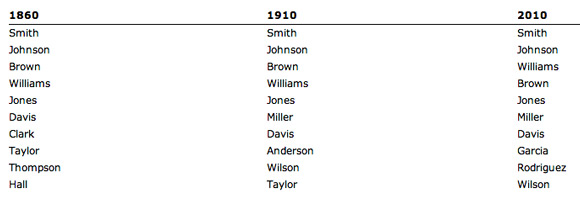The following press release is from Ancestry.com:
Ancestry.com Celebrates America’s Immigrant Influence by Revealing Name Trends Throughout History

PROVO, UT–(Marketwire – Mar 14, 2013) – Ancestry.com, the world’s largest online family history resource, is revealing name trends from the past 150 years to inspire Americans to learn more about their immigrant roots. Regardless of their varying backgrounds and cultures, one constant remained in our ancestors’ immigrant journeys — their last names came with them. Despite emigrating from various parts of the globe, the most common last names in the U.S. have remained the same during the past 150 years: Smith, Johnson, Williams, Brown and Jones. But times — and immigration patterns — are changing. In the most recent US Census (2010), Garcia and Rodriguez made it into the top ten list of last names for the first time.
Many of these common last names, or surnames, did not necessarily start out as common — they are rooted in other languages and were changed under the pressure to assimilate into new cultures. While many families share stories of how their last name evolved, some changes are more prevalent than others. One of the more common examples involves German immigrants changing ‘Schmidt’ to ‘Smith’ upon arrival on American soil. This makes sense, given that Smith has taken top billing as a last name since 1860 and more Americans identify themselves as having German roots (7 million) than any other group. Other top ethnic groups that immigrated to the US during the last two centuries include Mexico (5.5 million), Italy (5.3 million), Great Britain (5.1 million), and Ireland (5.1 million).
Wonder where your name stacks up? Take a look at the top 10 last names over the past 150 years:

Conversely, first names have undergone a dramatic shift over time. John and Mary, which were the most popular first names in 1860 and 1910, weren’t even in the top 25 in 2010. John used to be the first name of 1 in 20 American men. Now, the top names are Jacob for men and Isabella for women.
To learn more about the origins of their own names, Ancestry.com is giving consumers access to a huge assortment of online immigration records free from March 14-17. These records provide a wealth of information for those looking to learn more about their ancestors’ journey to the U.S.; showing when and how they first arrived on American soil.
“Immigration records are key to not only learning more about when and where your ancestors first came to the U.S., they can also help build a better picture of who your ancestors were as individuals,” said Dan Jones, Vice President of Global Content Strategy, Ancestry.com. “Ancestry.com is happy to offer everyone a chance to learn more about their family’s unique path in a fun and easy way.”
Immigration records on Ancestry.com contain a wide variety of documents including passport applications, records of border crossings, passenger lists and much more. Altogether, they span more than 300 years, from the early 1600s to the latter part of the 20th century. As well as providing vital information that can help further family history research, these documents offer a unique glimpse into the personal lives of our ancestors and provides ample opportunity for people to dig deeper into their immigration roots and track their ancestors’ movements across the globe.
Find out more about your ancestors’ immigration journey at Ancestry.com/immigration, where the company is offering free access to immigration records from March 14-17. One weekend not enough? Learn even more about your family history by signing up for a free 14-day trial of Ancestry.com.
About Ancestry.com
Ancestry.com Inc. is the world’s largest online family history resource, with more than 2 million paying subscribers. More than 11 billion records have been added to the site in the past 17 years. Ancestry users have created more than 45 million family trees containing more than 4 billion profiles. In addition to its flagship site www.ancestry.com, Ancestry.com offers several localized websites designed to empower people to discover, preserve and share their family history.